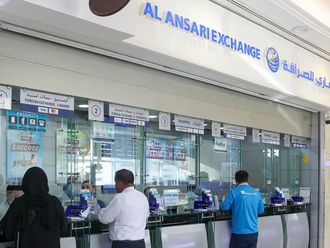Dubai: The Lebanese banking system is reeling from exposure to some of the countries impacted by political unrest in the region, particularly Syria and the country's own economic and political challenges.
Lebanese bank profits fell 12 per cent in the first nine months of last year. According to the last consolidated balance sheet of all commercial banks in Lebanon, the profits of these banks up to October reached $965 million (Dh3.54 billion) compared to $1.095 billion in the same period of 2010, a drop of $132 million.
This is probably the first time in years the Lebanese commercial banks suffered a drop in profits.
The year-to-date bank assets and customer deposits grew in 2011, but still remained a bit lower than their 2010 performance.
Financial results issued by the affiliates of seven Lebanese banks operating in Syria show their aggregate assets reached 341 billion Syrian pounds ($7.1 billion) at the end of September 2011, down 13 per cent from end of 2010, according to a recent report by the Byblos Bank Group.
The decline was due to an average drop of 24.3 per cent in the assets of Banque Bemo Saudi Fransi, Bank of Syria and Overseas and Bank Audi Syria — the three largest private commercial banks by assets. The banks' loans totalled 146 billion pounds ($3 billion) at the end of September.
The report did not say why assets and deposits fell last year although most observers and experts attribute this decline to the political and security turmoil in Syria.
Decline in loans
There were unconfirmed reports that some of the deposits fled to Lebanon. However, the Lebanese central bank and commercial banks denied any significant cash inflow from Syria last year.
The decline in loans was mainly caused by an average contraction of 21.3 per cent in the lending of Bank of Syria and Overseas and Bank Audi Syria in the first nine months of the year.
Also, customer deposits reached 262.6 billion pounds at the end of September, down 21.3 per cent in the first nine months of the year.
For the next 12 to 18 months rating agency Moody's expects the banks' profitability to come under pressure, as subdued business activity will likely cause a slowdown in credit growth and fee-generating income.
Combined with historically low interest rates and potential upward pressure on funding costs, Moody's expects the slowdown to exert pressure on banks' pre-provision income. At the same time, provisioning charges are likely to rise during the first half 2012, further suppressing net income.
The Lebanese banking system is highly exposed to Lebanon's sovereign debt. "Government debt on banks' balance sheets stood at a very high 3.4 times the system's aggregate Tier 1 capital at year-end 2010, whilst the wider exposure to the Lebanese government is estimated to have been even higher, at over 6.1 times Tier 1 capital," Moody's said in a recent rating update. The rating agency does not expect a material shift in the composition of the banking sector's balance sheet over the outlook horizon; therefore, the banks' credit risk profile will continue to be closely linked to that of the Lebanese government.
Risk assessment
The banking system's liquidity buffers and resilient depositor base will likely be maintained over the outlook horizon, thereby mitigating some of the downside risks.
According to central bank statistics, highly liquid assets and placements with predominantly international banks account for approximately 25 per cent of total assets.
In addition, the sector retains a relatively stable funding structure driven by customer deposits, which account for about 90 per cent of liabilities. Supporting these deposits is the resilient influx of remittances (22 per cent of GDP in 2010).
Rating agency Standard & Poor's said recently that Lebanese banks' risk assessment slightly diminished last year although the risk ranking still remains very high. S&P revised upward Lebanon's Banking Industry Country Assessment to Group ‘eight' from Group ‘nine' and its economic risk score to ‘9' from ‘10,' while it assigned an industry risk score of six.
S&P indicated that Lebanon's economic risk score reflects its "very high risk" in terms of economic resilience, its "high risk" in economic imbalances, and its "extremely high risk" in terms of credit risk in the economy.












